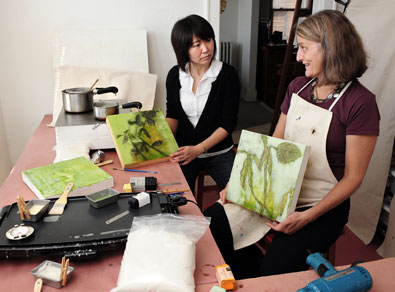Inside Iowa State
Inside ArchivesSubmit newsSend news for Inside to inside@iastate.edu, or call (515) 294-7065. See publication dates, deadlines. About InsideInside Iowa State, a newspaper for faculty and staff, is published by the Office of University Relations. |
Jan. 16, 2009 
Tong Wang (left) and Barbara Walton are working together to modify soy wax so it works in the centuries-old encaustic painting technique. Photo by Bob Elbert. Soy research offers greener materials for hot wax artby Melea Reicks Licht, Agriculture and Life Sciences Communications The art world could be looking a little greener, thanks to the efforts of two Iowa State professors. Tong Wang, associate professor of food science and human nutrition, is working with Barbara Walton, associate professor of art and design, to modify soy wax for use in encaustic art. Their collaboration is funded by a grant from the Center for Excellence in the Arts and Humanities. The historic painting technique, used since before 500 A.D., involves adding colored pigments to heated wax and applying it to wood or canvas. Soy wax offers a safer, more affordable and environmentally friendly medium than the petroleum-based microcrystalline wax or costly beeswax traditionally used in encaustic painting. The research team is comparing the functional properties of soy wax with microcrystalline wax and beeswax, their physical stability and the conceptual aspects of art made from them. Wang and postdoctoral assistant Hui Wang focused on changing soy's molecular bonds. "We alter the structure of partially hydrogenated soybean oil to improve the wax's properties for use as an encaustic medium," Wang said. "We modify the soy molecules to make them behave like beeswax with improved cohesiveness." She relies on Walton's feedback to know to what degree to alter the oil to make the wax more suitable for painting. Wang delivers the wax to Walton as flakes or cakes. Walton applies it to her canvas in a molten state after heating it on a hot palette and tinting it with pigments. "This brings out the scientist in me. I'm very explorative, and I like using new materials," Walton said. Walton has been working with encaustic painting for more than seven years and said she especially appreciates that the soy wax comes from a more sustainable source than microcrystalline and a more affordable source than beeswax. Wang and Walton will continue to refine soy wax to perform more like traditional encaustic waxes for stability and archival quality. Wang, whose other work includes development of soy candles, said the research holds potential for improving soy crayons or edible wax coatings for fresh produce. |
Quote"We modify the soy molecules to make them behave like beeswax with improved cohesiveness." -- Tong Wang |